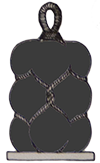THE 74 GUN SHIP Pratical Treatise of Naval Art 1780
THE 74 GUN SHIP Pratical Treatise of Naval Art 1780 In four volumes. The cornerstone of our collection.
TIMBERING PLANS THE 74-GUN SHIP
New 2019: Sail plans for 74-gun Ship at scale 1/72 or 1/48.
 En stock
En stock




This 4 volume set is the starting point of our collection and as such is almost essential to the understanding of all our other books. It gives the definitions of all parts of a ship, " from keel to mast's truck", illustrated with many detailed drawings. It also explains how to manœuvre and operate a ship, and what shipboard life was like. ...
This 4 volume set is the starting point of our collection and as such is almost essential to the understanding of all our other books. It gives the definitions of all parts of a ship, " from keel to mast's truck", illustrated with many detailed drawings. It also explains how to manœuvre and operate a ship, and what shipboard life was like.
In order to avoid unnecessary repetitions, these explanations and definitions are not given in our other publications, in which you will find numerous cross-references to "The 74 Gun Ship".
ABOUT THE AUTHOR
Jean Boudriot is an exceptional Frenchman. Originally an architect, he is an outstanding draughtsman and in only a few years' time became the first specialist in 17th and 18th century naval architecture. He was first interested in the study of French statutory arms, on which he published four books that were accepted as authorities. In 1960, he moved on to studying naval archeology.
J. Boudriot's first studies on naval guns, published in 1969 in Neptunia, are true revelations for amateurs. Between 1973 and 1977, he published the four volumes of "The 74 GUN SHIP" thus creating the Boudriot myth. Since then, he has dedicated his time to scouring the archives in Paris in winter, and to drawing in Charente in summer. For our utmost pleasure, Jean Boudriot regularly publishes the monographs and historical studies that constitute the French Naval Archeology Collection.
Boudriot is both an author and a publisher. He also teaches the weekly naval archeology seminar that takes place in the Musée de la Marine, and gives numerous lectures, most of them in the Sorbonne. He is a talented speaker and hearing him speak on his topic is an enchanting event.
THE METHOD
While the shape of things to come is not set at the beginning of the book, principles are well established there. Boudriot started with primary sources by systematically studying models in the arsenals and by doing daily archival research in every harbour in France. He neglected nothing : neither the theoretical contributions brought by such authors as Duhamel du Monceau, Romme, Bouguer or Vial du Clairbois, nor the valuable iconographic documents provided by such draughtmen as Puget, Ozanne, Vernet, Guéroult du Pas and Sponsky de Passebon, etc. But the practical drawing booknotes of anonymous engineers, the more modest wood estimates by master carpenters or the inventories of a warehouse were even more important.
Only the irrefutable document is to be taken into account : engineers' plans, construction, equipping and campaigning estimates; correspondence and manuscripts of the time.
Because of his talent as a draughtman and because of his architect's training, Jean Boudriot is convinced that naval archeology - because it is a restitution of the past - can only be approached through drawing, the only true means of expression and understanding it. His rigorous and magical lines, with their lively and familiar style, immerse the reader in the atmosphere of the 17th, 18th and 19th ports and ship building sites throughout his numerous books.

THE SHIP
As the main naval war machine at the end of the 18th century, the 74 Gun Ship was the result of a compromise, like every successful vessel. Her balance between strong guns and manoeuvrability offered by the 28 gun lower gundeck and firing 36 pound cannon-balls, made the "74" the perfect ship of the line. Since she moved more easily, she was much more useful in combat than the heavy 100 gun three-decker.
Her hull alone represented half of 3000 tons moving. 2800 hundred-year-old oak trees (a whole forest), and 600 tons of iron and wood bolts were needed for her construction. The hold and its orlop-deck could contain victuals for 6 months and water for 12 weeks. The gundeck had to bear the considerable weight of enormous 36-pdr guns, weighing 4 tons each. The upper deck, covered front and back with castles, carried lighter guns.
This hull rose 7 meters above water and carried prodigious flights of sails. Each of the three masts, in three elements, rigged three floors of square sails and the main top-mast truck towered at 60 meters. This ship was well designed by her engineer and when correctly used by her crew, she performed superbly at sea in all weathers. In a fair breeze, she could exceed ten knots by sailing quartering.
BOOK 1
I. ADMINISTRATION OF THE PORTS AND DOCKYARDS
1. General organisation
2. Surveyors
3. Summary table
Il. THE WORK OF THE SURVEYORS
1. Qualities demanded of a warship
2. Study of the hull shapes
3. Ships' draughts
4. Calculations
5. Specification
III. THE WORK OF THE SHIPWRIGHTS
1. Moulding in the loft
2. Marking out and fashionning in the yard
IV. MATERIALS
1. Timber
2. Hemp
3. Metals
4. Others materials
V. DOCKYARD INSTALLATIONS
1. Slipway and keel blocks
2. Raising and horning of the timbers
3. Launching
BOOK 2
VI. HULL TIMBERS
1. Keel and stem timbers
2. The station frames
3. Stern-frames
4. Filling timbers
5. Reinforcement and planking of the hold
6. Construction of the decks
7. Internal planking above the hold
8. Description of other inboard works
9. External planking of the hull
VII. FASTENING - CAULKING
1. Nails, fastening
2. Nailing, fixing of bold
3. Oakum, pitch
TABLES, ETC
VIII. HULL FITTING
1. The bow
2. The ship's sides
3. The stern
IX. INTERNAL ARRANGEMENTS
1. The hold and orlop
2. The gundeck
3. The upper deck
4. The forecastle, quaterdeck and poop
5. The officers' quarters
6. Paintwork
X. BALLAST AND STOWAGE
1. Ballast
2. Stowage
3. Victuals
XI. WARRANT-OFFICIERS' STORES
1. The Bo'sun
2. The Cook and the Baker
3. The Master
4. The Carpenter
5. The Caulker
6. The Gunner
7. The Master-at-Arms and the Armourer
8. The ship's boats
9. The Chaplain
10. The Surgeon
11. The midshipmen
SUNDRY ITEMS OF STORES
BOOK 3
XII. MASTING
1. General considerations
2. Type of timber and mast-making
3. Standing masts
4. Others spars and spares
5.Mast furniture.
XIII. SAILS
1. Sailcloth and sailmaking
2. List of the sails and their proportions.
XIV. RIGGING
1.Ropemaking and related skills
2.Blocks and block-making
3.Standing rigging
4.Running rigging - yards
5.Running rigging - sails
6.Anchors cables and related ropes
7.Rigging of the ship's boats
XV. MAINTENANCE
GENERAL NOTIONS REGARDING SHIPS OF WAR
NAVY LIST 1780
COST OF BUILDING A 74
OTHER NAVAL VESSELS
BOOK 4
XVI. THE CREW
1. Officers - Volunteers - Midshipmen
2. The men
3. The Marines
4. Supernumeraries
XVII. OFFICERS AND CREW AT WORK
1. Functions - Responsabilities
2. Watch-bill, Quater-bill, messing
3. Policing - Discipline
4. Seamanship
5. Fighting drill
XVIII. LIFE ON BOARD
1. Clothing - Berthing - Other details
2. Religious observance
3. Victuals
4. Health and health care
XIX. SHIPHANDLING
1. The ship in harbour
2. Anchored in the roads
3. Shiphandling at sea
XX. NAVAL EVOLUTIONS AND OPERATIONS
1. Single ship evolutions
2. Fleet operations
XXI. NAVIGATION, COLOURS AND SIGNALS
1. Navigation instruments
2. Navigation
3. Flags, colours and signals
SUPPLÉMENT
VOCABULARY
Author : Jean Boudriot
No customer comments for the moment.






















